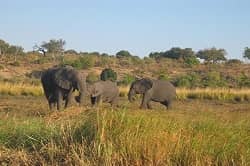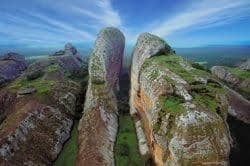Angola Top Tourist Destinations
Angola is a reserve of natural forests and animals and people from different countries visiting every time to get spellbound by the scenic beauty and natural beauty that Angola beholds within itself.
Angola is a Southern African nation whose varied terrain encompasses tropical Atlantic beaches, a labyrinthine system of rivers and Sub-Saharan desert that extends across the border into Namibia. The country's colonial history is reflected in its Portuguese-influenced cuisine and its landmarks including Fortaleza de São Miguel, a fortress built by the Portuguese in 1576 to defend the capital, Luanda
1. Luanda Capital of Angola
Luanda, the capital of Angola, is a port city on the west coast of Southern Africa. A seafront promenade known as the Marginal runs alongside Luanda Bay. Nearby is the well-preserved 16th-century Fortress of São Miguel, which now contains the Museum of the Armed Forces. The fort has views of the harbor and the Ilha do Cabo, a long, thin peninsula in the bay that’s home to beaches, bars and restaurants.
Behind the Marginal, the Baixa de Luanda district features Portuguese colonial architecture, including the vast National Bank of Angola, with its striking pink facade. Nearby is the restored 17th-century Nossa Senhora de los Remedios cathedral. The Agostinho Neto Memorial Mausoleum is a towering obelisk that commemorates Angola’s first president. Southwest of the city, in Morro da Cruz, the National Slavery Museum is in a chapel where slaves were once baptized. Nearby Mussulo Peninsula is known for its beaches. Farther south, Quiçama National Park protects coastal savanna and indigenous animals such as elephants and antelopes.
Angola Ruacana Falls
Ruacana Falls: Ruacana Falls are waterfalls located near Ruacana on the Kunene River in Northern Namibia. The waterfall is 120 meters high and 700 meters wide in full flood. It is among the largest waterfalls in Africa, both by volume and width. The Ruacana Dam and power station, together with the Calueque Dam 25 miles farther upriver in Angola, are designed to provide irrigation water for southern Angola and the Owambo region of northern Namibia as well as to provide electricity for most of Namibia. It was a beautiful and spectacular view.
When to visit Luanda
A popular time to visit is during the dry season (May–Sep), when temperatures are slightly cooler than the rest of the year and there’s very little rain. The rainy season (Oct–Apr) sees warmer and more humid conditions. The Luanda International Jazz Festival (Jul–Aug) is an annual event featuring Angolan and international musicians.
Parque Nacional do Quicama
Massive park with tourist lodgings that has reintroduced wildlife such as elephants & giraffes. Around 75 kms from Luanda trough cost road lays Angola best know Wildlife Park Quiçama. They do have a lodge in the park and is better to make reservations in advance mostly for weekends spend outs. Not a luxury lodge but you get the basic to have a good stay. They do have a safari service and it may be difficult to view animals sometimes. A good hideout for the busy Luanda´s life. Very good views from the lodge to the surrounded area.
Quiçama National Park Quiçama National Park, also known as Kissama National Park, is a national park in northwestern Angola. It is the only functioning national park in all of Angola, with the others being in disrepair due to the Angolan Civil War. The park is approximately 70 km from Luanda, the Angolan capital. The park covers 3 million acres, more than twice the size of the U.S. state of Rhode Island. The Portuguese name Quiçama is spelled in English and other languages as Kissama, Kisama or Quicama. The spelling Kissama in English is the closest to the Portuguese phonetic.
When to visit Quicama
Quiçama National Park has a tropical climate with warm weather year-round. The dry season (May–Aug) is popular for safaris. In the rainy season (Oct–May), roads can become impassable and the lush vegetation makes wildlife harder to spot.
Lubango Municipality in Angola
Lubango, formerly known as Sá da Bandeira, is a municipality in Angola, capital of the Huíla Province, with a population of 776,249. The city center has a population of 600,751 making it the second largest city in Angola after the capital city Luanda.
Lobito Municipality in Angola
Lobito is a municipality in Angola. Located in the Benguela Province, on the Atlantic Coast north of Catumbela Estuary. Lobito municipality had a population of 393,079 in 2014.
Cameia National Park
Cameia National Park is a national park in the Moxico province of Angola, located at about 1100 m above sea level. It shares its name with the nearby municipality of Cameia. The Cameia–Luacano road forms the northern boundary of the park with the Chifumage River forming the southern portion of the eastern boundary and the Lumege and Luena rivers the south-western boundary. Much of the park consists of seasonally inundated plains that form part of the Zambezi river basin, with the northern half of the park draining into the Chifumage river. There are also extensive miombo woodlands, similar to those in the Zambezi basin of western Zambia. The park is a sample of nature not occurring elsewhere in Angola. Two lakes, Lago Cameia and Lago Dilolo lie outside the park boundaries and both have extensive reedbeds and grassy swamps that are rich in aquatic birds.
Cangandala National Park
Cangandala National Park is another visitor attraction in Angola. It is the smallest National Park in the country and is situated in the Malanje province. It is situated between the Cuije river and 2 unnamed territories of the Cuanza River, with the towns of Culamagia and Techongolola on the edges of the park. The park was created in 1963 while Angola was still under Portuguese colony
Iona National Park
Iona National Park , located in Namibe Province, is another popular tourist destination. It is about 200 kilometres (120 miles) from the city of Moçâmedes and, at 15,200 square kilometres (5,850 square miles), the largest in the country. Before the Angolan Civil War, Iona was an "animal paradise, rich in big game". However, as is true for most Angolan national parks, illegal poaching and the destruction of infrastructure have caused considerable damage to the once rich park. The park is also known for unique flora and incredible rock formations
Iona National Park is the largest national park in Angola. It is situated in the Southwestern corner of the country, in Namibe Province. It is roughly bound by the Atlantic Ocean to the West, an escarpment to the East that marks the beginning of the interior plateau, the Curoca River to the North, and the Cunene River to the South. It is about 200 kilometres south of the city of Namibe and covers 5,850 square miles sq. miles. The topography of Iona is characterised by shifting dunes, vast plains, and rough mountains and cliffs. Annual average precipitation is no more than 30 mm. The Curoca River is intermittent but has lagoons, while the Cunene is permanent and has marshy areas at its mouth. Iona was proclaimed as a reserve in 1937 and upgraded to a national park in 1964. However, as is true for most Angolan parks, the Angolan Civil War greatly disrupted the area. Poaching and the destruction of infrastructure have caused considerable damage to the once rich park. In recent years, a number of government and international projects have worked on rebuilding the infrastructure of the park, which will hopefully invite tourists back.
Mupa National Park
Mupa National Park in the southwestern Cunene province was proclaimed a National Park on 26 December 1964 while the country was still a Portuguese colony. The park is significant for its expected wide (though generally unstudied) avifauna. Many Angolans reside within the park, which, along with nomadic pastoralists and mineral prospecting threatens to destroy the park's birdlife. According to one article, "Even though the park was initially proclaimed to protect the giraffe sub-species, Giraffa camelopardalis angolensis, by 1974 none were left because the morphology of the White Giraffe leaves it particularly vulnerable to landmines left over from Angola's civil war compared to other giraffe sub-species. Other mammals which occurred, include lion, leopard, wild dog and spotted hyena". Mupa National Park


